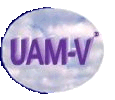|
In the full
version of this animation, UAM-V® simulated hourly averaged
concentrations (ppb ozone) are interpolated to ten-minute intervals.
The time of the simulation is depicted in the upper left corner
and the maximum concentration in the region for the corresponding
time period is depicted in the upper right corner. The color scale
ranges from 40 to >190 ppb. Black denotes ozone concentrations
less than 40 ppb.
Wind directions
along the Gulf Coast were initially northerly on 1 August, became
variable, and turned westerly along the coast by 2 August. The meteorological
inputs were prepared using MM5, with four dimensional data assimilation
and 4 km horizontal resolution with 20 vertical layers.
Some interesting
features of the simulation/animation are:
- Ozone concentrations
exceed 100 ppb after 1200 hours on 1 August and 1000 hours on
2 August
- Ozone concentrations
exceed 120 ppb by 1200 hours on 2 August
- On 2 August,
highest concentrations are calculated south of Pascagoula (over
the Gulf) and in Atlanta by 1400 hours, and later in the Houston
area.
- Ozone concentrations
exceed 100 ppb off-shore in the Gulf and are transported easterly
and southerly during the nighttime hours parallel to the coastline.
This simulation
is one of three multi-day episodes. It forms a part of the 1-hour
State Implementation Plan (SIP) for Baton Rouge, Louisiana. Using
projected emissions for 2005, the SIP demonstrates attainment of
the U. S. 1-hour ambient air quality standard of 120 ppb. Animation
of the projected 2005 ozone air quality is not presented here. The
modeling domain used is Grid 2 of the Gulf Coast Ozone Study (GCOS)
modeling domain (see gcos.saintl.com).
Back
to top
Back to Information
|

